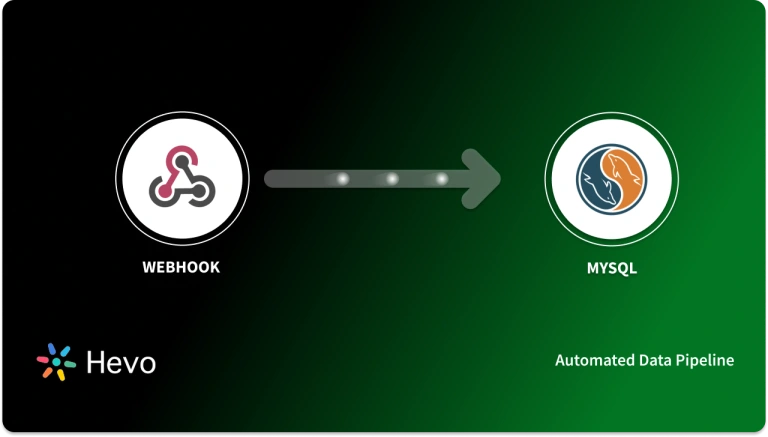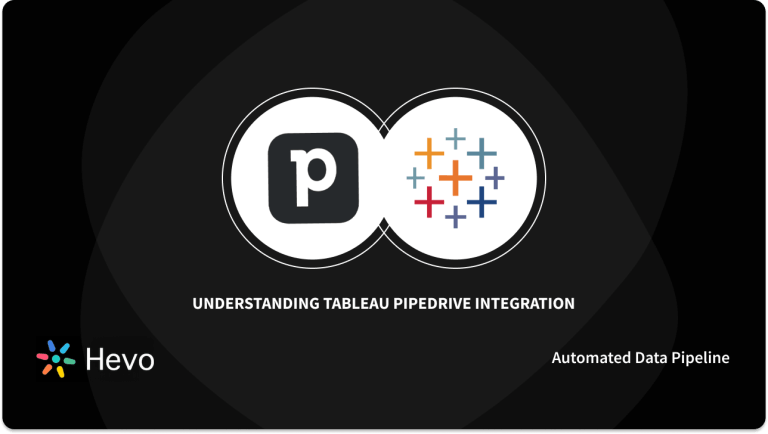Moving your Pipedrive data to MySQL gives you big benefits: better data analysis, custom reports, easy connection with business tools, and faster performance for complex searches that help you make smart business decisions.
This guide walks you through two proven methods to sync your Pipedrive data with MySQL. Whether you’re a small team looking for a quick setup or an enterprise needing advanced customization, we’ll show you exactly which method fits your situation. You’ll get complete step-by-step instructions, troubleshooting tips for common roadblocks, and practical examples to get your integration running smoothly.
By the end of this guide, you’ll have your sales data flowing seamlessly into MySQL, ready for powerful analysis. Let’s get started.
 Key Takeaways
Key TakeawaysThere are two straightforward approaches to connect Pipedrive to MySQL, each suited for different business needs:
- Using Hevo’s No-Code Data Pipeline: This is ideal if you want everything done automatically with minimal technical work. Hevo takes care of moving your data, resolving any issues, and keeping everything up to date in real-time.
- Using Pipedrive REST APIs: This method works well for developers in your team who want to customize exactly how the data moves. You get complete control over your data, with ease to switch settings matching your specific business needs.
Table of Contents
How to Set up Pipedrive MySQL Integration?
Method 1: Using Hevo Data to Set up Pipedrive MySQL Integration
Prerequisites
- Active Pipedrive account with data access.
- Assigned Team Administrator, Collaborator, or Pipeline Administrator role in Hevo.
- Hevo app installed and required permissions granted in Pipedrive.
Step 1: Configure Pipedrive as a Source in Hevo
- In the Hevo dashboard, go to Pipelines → + CREATE PIPELINE.
- Select Pipedrive as the Source Type.
- Choose an existing Pipedrive account or click + ADD PIPEDRIVE ACCOUNT and log in.
- Click Allow and Install to authorize Hevo’s access.
- Configure the pipeline:
- Enter a Pipeline Name (max 255 characters).
- Set Historical Sync Duration (up to 30 days).
- Click TEST & CONTINUE to verify settings before moving ahead.
Step 2: Set Up Data Ingestion and Destination Preparation
Prerequisites
- MySQL server running (not localhost), version 5.5 or higher. Confirm with below command:
service mysql status
mysql -V- Hevo’s IP addresses whitelisted in the MySQL server config.
- Database user created with privileges: ALTER, CREATE, DELETE, DROP, INSERT, SELECT, UPDATE.
Whitelist Hevo IP Addresses
- Edit MySQL config file (e.g., /etc/mysql/mysql.conf.d/mysqld.cnf).
- Update the bind-address to 0.0.0.0 (allow all IPv4), or Specific Hevo IP(s) for your region Remove/comment out any line with skip-networking.
Step 3: Configure MySQL as a Destination in Hevo
- Login as root and create user:
<code>CREATE USER '<user_name>'@'%' IDENTIFIED BY '<password>';- Grant necessary privileges:
<code>GRANT ALTER, CREATE, CREATE TEMPORARY TABLES, DELETE, DROP, INSERT, SELECT, UPDATE ON <database_name>.* TO '<user_name>'@'%';- In Hevo dashboard, go to Destinations → + CREATE DESTINATION → Select MySQL.
- Fill details:
- Destination Name (max 255 characters).
- Database Host (IP or DNS), Port (default 3306).
- Database User and Password (created earlier).
- Database Name where data will be loaded.
- Optional settings:
- Enable Connect through SSH for secure tunnels.
- Enable Use SSL and upload certificates if required.
- Enable Sanitize Table/Column Names to avoid naming conflicts.
- Click TEST CONNECTION and then SAVE & CONTINUE after successful validation.
You can now create the pipeline to start syncing your Pipedrive sales data to MySQL automatically and effortlessly with Hevo!
Method 2: Using REST APIs to Set up Pipedrive MySQL Manual Integration
Step 1: Set Up Pipedrive as Source
Before writing any code, log in to your Pipedrive account and:
- Navigate to Settings → Personal Preferences → API.
- Copy your API token.
- Decide which data you want to pull (e.g., persons, deals, organizations).
- Use the base endpoint format:
https://api.pipedrive.com/v1/{resource}?api_token={your_token}
For example, define the API Config in Code
Step 2: Prepare MySQL as the Destination
import requests
# Your Pipedrive API token and endpoint for 'persons'
API_TOKEN = 'your_pipedrive_api_token'
API_URL = f'https://api.pipedrive.com/v1/persons?api_token={API_TOKEN}'In your MySQL database:
- Create a table to store the data you’re pulling (e.g., persons).
- Define the primary keys and data types based on the API response fields.
For example, Create MySQL Config and Table
-- MySQL Table Schema (run in your SQL console)
CREATE TABLE persons (
pipedrive_id INT PRIMARY KEY,
name VARCHAR(255),
email VARCHAR(255),
phone VARCHAR(50)
);
import mysql.connector
from mysql.connector import Error
# MySQL connection settings
MYSQL_CONFIG = {
'host': 'your_mysql_host',
'database': 'your_database_name',
'user': 'your_mysql_user',
'password': 'your_mysql_password'
}Step 3: Extract Data from Pipedrive (Source)
- Use the Pipedrive API to fetch data in JSON.
- Loop over pages if you have more than 100 records.
For example, below code help to fetch function for Pipedrive API
def fetch_pipedrive_data(url):
all_data = []
start = 0
while True:
response = requests.get(f"{url}&start={start}")
response.raise_for_status()
data = response.json()
if not data['data']:
break
all_data.extend(data['data'])
if not data['additional_data']['pagination']['more_items_in_collection']:
break
start = data['additional_data']['pagination']['next_start']
return all_dataStep 4: Load Data into MySQL (Destination)
- Connect your script to MySQL and push the extracted data via INSERT or UPSERT.
For example, to insert data into MySQL Table
def load_data_to_mysql(records):
try:
connection = mysql.connector.connect(**MYSQL_CONFIG)
cursor = connection.cursor()
for record in records:
# Extract values (adjust fields as needed)
person_id = record.get('id')
name = record.get('name')
email = record.get('email')[0]['value'] if record.get('email') else None
phone = record.get('phone')[0]['value'] if record.get('phone') else None
# Insert or update into MySQL table
query = """
INSERT INTO persons (pipedrive_id, name, email, phone)
VALUES (%s, %s, %s, %s)
ON DUPLICATE KEY UPDATE
name = VALUES(name),
email = VALUES(email),
phone = VALUES(phone)
"""
cursor.execute(query, (person_id, name, email, phone))
connection.commit()
cursor.close()
except Error as e:
print("MySQL Error:", e)
finally:
if connection.is_connected():
connection.close()Now, to run the Full Sync you can use the below main.py script:
if __name__ == '__main__':
raw_data = fetch_pipedrive_data(API_URL)
load_data_to_mysql(raw_data)
print(f"{len(raw_data)} records synced from Pipedrive to MySQL.")Done! You’ve now got a working Pipedrive → MySQL sync process using REST APIs that can easily be scheduled using CRON or extended to other Pipedrive endpoints.
What is Pipedrive?

Pipedrive is a web-based CRM and Pipeline Management tool designed to help businesses plan and track their sales activities. Built around an activity-based selling methodology, Pipedrive streamlines every step of the sales process, helping convert potential deals into successful sales. The platform is highly customizable, allowing you to design your own unique sales processes and workflows without being tied to predefined standards.
One of Pipedrive’s key strengths is its flexibility. It doesn’t just track and report on pipeline stages—it also correlates data efficiently. Sales professionals often bring in spreadsheets and complex data sets, and Pipedrive helps turn that information into actionable insights.
Key Features of Pipedrive
Some of the key features of Pipedrive are as follows:
- Reporting: Pipedrive contributes to greater insight and active reporting. Measuring a company’s performance against a specific set of objectives becomes critical when developing an optimized Sales technique.
- Automation: One of the primary reasons businesses prefer Pipedrive is that it automates various sales operations.
- Third-Party Integrations: Businesses can use Pipedrive in conjunction with a number of third-party applications to increase sales and generate invoices. This is a standard requirement, especially when a company’s management is attempting to access customer information and make changes via their mobile phones. Pipedrive also allows employees to use their existing set of applications in conjunction with it.
- Custom Templates: Employees can use Pipedrive to create their own templates and insert images & context to improve their Sales Funnel. A customized format or template can also assist employees in fine-tuning metrics that must be observed when comparing.
What is MySQL?
MySQL is a SQL-based RDBMS (Relational Database Management System). A database is a structured collection of data and a relational database, in particular, is a digital store that collects and organizes data using the Relational Model. Tables in this model are made up of rows and columns, and all relationships between data elements adhere to a strict logical structure.
An RDBMS is simply a collection of software tools used to Implement, Manage, and Query a database.MySQL is a critical component of most of the popular software stacks used for developing and managing everything from customer-facing web applications to powerful, data-driven B2B services. Owing to its open-source nature, stability, and rich feature set, combined with ongoing development and support from Oracle, MySQL backends are used by Internet-critical organizations such as Facebook, Flickr, Twitter, Wikipedia, and YouTube.
Benefits of using MySQL
Some of the key advantages of using MySQL are as follows:
- Easy to Deploy: MySQL allows businesses to set up and run SQL queries on their data in minutes. MySQL enables them to develop new applications faster than proprietary databases.
- High Speed: It goes without saying that if you’re working with large datasets, you would not want to spend a lot of time working with datasets and tables. Unlike other databases, MySQL is relatively faster and can query data from large datasets, which aids in business intelligence activities.
- Industry Standards: Whether you are a developer who needs to develop software or a freelancer who wants to work with databases, MySQL has been in use for over 20 years and you can rely on it to be a fully integrated Transaction-Safe, ACID-Compliant database.
Due to business and analytical requirements, organizations need to migrate data to MySQL. Here, you will learn 2 methods that will help you migrate your data from Pipedrive, a CRM-based SaaS source to MySQL, a Relational Database Management System, and build Pipedrive MySQL Integration.
Method 1: Load Data From Pipedrive to MySQL using Hevo’s No Code Data Pipeline
Hevo Data, an Automated No-code Data Pipeline, helps you load data from Pipedrive to MySQL in real-time and provides you with a hassle-free experience. You can easily ingest data using Hevo’s Data Pipelines and replicate it to your desired Data Warehouse/Database like MySQL without writing a single line of code.
Method 2: Load Data from Pipedrive to MySQL using Pipedrive REST APIs
In this method, you will learn about various resources available in Pipedrive that can be loaded into MySQL using Pipedrive APIs.
GET STARTED WITH HEVO FOR FREEAdvantages of setting up Pipedrive MySQL Integration
Now that you have understood the various methods of setting up Pipedrive MySQL Integration, let’s check out some of the key benefits this integration offers:
- Produce Actionable Insights: You can leverage the Pipedrive MySQL Integration to gain deep insights into your business by harnessing the power of Data Analytics. Large amounts of historical data can be managed and processed without affecting performance.
- Create Backup of Important Data: You can load data from Pipedrive to MySQL to create a backup for critical data. If you lose Pipedrive data due to a server breakdown, an accidental deletion, or other disasters, you can restore it or move it to another machine.
- Build Interactive Dashboards: You can also use a Data Visualization tool to build interactive dashboards using the migrated data.
You can also learn more about:
- MySQL on Amazon RDS to BigQuery
- MySQL on Amazon RDS to Redshift
- MySQL on Amazon RDS to Databricks
- MySQL on Amazon RDS to PostgreSQL
Conclusion
In this article, you gained a basic understanding of Pipedrive and MySQL. You also explored the 2 methods to set up Pipedrive MySQL integration. At the end of this article, you discovered the various advantages of setting up the Pipedrive MySQL Integration. However, knowing where to start and how to combine consumer data from various applications can be a challenge for many companies. This is where Hevo can help save your day!
Hevo Data is a No-Code Data Pipeline that offers a faster way to move data from 150+ Data Sources such as Pipedrive to a destination of your choice such as MySQL. Hevo is fully automated and hence does not require you to code.
Want to take Hevo for a spin?
SIGN UP for a 14-day free trial and experience the feature-rich Hevo suite first hand. You can also have a look at the unbeatable pricing that will help you choose the right plan for your business needs.
Share with us your experience of learning about the methods used for setting up Pipedrive MySQL integration in the comments below.
Frequently Asked Questions
1. What does Pipedrive integrate with?
Pipedrive integrates with a wide variety of tools and platforms to enhance its CRM capabilities.
2. What is MySQL integration?
MySQL Integration refers to connecting MySQL databases with other applications or systems to enable data exchange, synchronization, and interaction.
3. Is Pipedrive a US company?
No, Pipedrive is not a US company.




